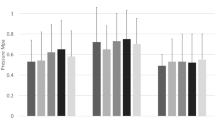Abstract
The objective of this study was to evaluate the effects of the biceps femoris tenodesis and popliteofibular ligament reconstruction on knee biomechanics. Ten human cadaveric knees were tested in the intact, posterolateral corner (PLC)-deficient, and PLC-reconstructed conditions using a robotic/universal force moment sensor testing system. The knees were subjected to: (1) a 134 N posterior tibial load, and (2) a 10 Nm external tibial torque applied to the tibia at full extension, 30° and 90° of flexion. External tibial rotation of the intact knee ranged from 18.3±4.6° at full extension to 27.9±4.6° at 30° under the 10 Nm external tibial torque. These values increased after sectioning the PLC by 2.8°–7.5° at 30° and 90° respectively. After the popliteofibular ligament reconstruction, external tibial rotation values were not significantly different from those for the intact knee at any angle tested, while values following the biceps tenodesis were as much as 5.7° greater than the intact knee. Under the 134 N posterior tibial load, there were minimal decreases in posterior tibial translation of up to 0.9 mm with the biceps tenodesis and up to 1.6 mm with the popliteofibular ligament reconstruction compared to the intact knee. The in situ forces in the biceps tenodesis were not significantly different than the intact PLC at full extension or 30°, while the in situ forces in the popliteofibular graft were not significantly different at any flexion angle. Our data suggests that by restoring external tibial rotation the popliteofibular ligament reconstruction more closely reproduces the primary function of the PLC as compared to the biceps tenodesis.




Similar content being viewed by others
References
Clancy WG (1988) Repair and reconstruction of the posterior cruciate ligament. In: Chapman MW (ed) Operative orthopaedics. Lippincott, Philadelphia, pp 1651–1665
Fanelli GC, Edson CJ (1995) Posterior cruciate ligament injuries in trauma patients, part II. Arthroscopy 11:526–529
Fanelli GC, Giannotti BF, Edson CJ (1996) Arthroscopically assisted combined posterior cruciate ligament/posterior lateral complex reconstruction. Arthroscopy 12:521–530
Flemming RE Jr, Blatz DJ, McCarroll JR (1981) Posterior problems in the knee: posterior cruciate insufficiency and posterolateral rotatory insufficiency. Am J Sports Med 9:107–113
Gollehon DL, Torzilli PA, Warren RF (1987) The role of the posterolateral and cruciate ligaments in the stability of the human knee. A biomechanical study. J Bone Joint Surg 69:233–242
Grood ES, Stowers SF, Noyes FR (1988) Limits of movement in the human knee. Effect of sectioning the posterior cruciate ligament and posterolateral structures. J Bone Joint Surg 70:88–97
Harner CD, Hoher J (1988) Evaluation and treatment of posterior cruciate ligament injuries. Am J Sports Med 26:471–482
Harner CD, Hoher J, Vogrin TM et al (1998) The effects of a popliteus muscle load on in situ forces in the posterior cruciate ligament and on knee kinematics. A human cadaveric study. Am J Sports Med 26:669–673
Harner CD, Vogrin TM, Hoher J et al (2000) Biomechanical analysis of a posterior cruciate ligament reconstruction. Am J Sports Med 28:32–39
Hoher J, Harner CD, Vogrin TM et al (1998) In situ forces in the posterolateral structures of the knee under posterior tibial loading in the intact and posterior cruciate ligament-deficient knee. J Orthop Res 16:675–681
Hughston JC, Jacobson KE (1985) Chronic posterolateral rotatory instability of the knee. J Bone Joint Surg 67:351–359
Kannus P (1989) Nonoperative treatment of grade II and III sprains of the lateral ligament compartment of the knee. Am J Sports Med 17:83–88
Lipscomb AB Jr, Anderson AF, Norwig ED et al (1993) Isolated posterior cruciate ligament reconstruction. Long-term results. Am J Sports Med 21:490–496
Loos WC, Fox JM, Blazina ME et al (1981) Acute posterior cruciate ligament injuries. Am J Sports Med 9:86–92
Maynard JM, Deng X, Wickiewicz TL et al (1996) The popliteofibular ligament. Am J Sports Med 24:311–316
Mann RA, Hagy JL (1977) The popliteus muscle. J Bone Joint Surg 59:1924–1927
Noyes FR, Barber-Westin SD (1996) Surgical restoration to treat chronic deficiency of the posterolateral complex and cruciate ligaments of the knee joint. Am J Sports Med 24:415–426
Rudy TW, Livesay GA, Woo SL et al (1996) A combined robotic/universal force sensor approach to determine in situ forces of knee ligaments. J Biomech 29:1357–1360
Seebacher JR, Inglis AE, Marshall JL et al (1982) The structure of the posterolateral aspect of the knee. J Bone Joint Surg 64:536–541
Staubli HU (1994) Posteromedial and posterolateral capsular injuries associated with posterior cruciate ligament insufficiency. Sports Med Arthrosc Rev 2:146–164
Sugita T, Amis AA (2001) Anatomic and biomechanical study of the lateral collateral and popliteofibular ligaments. Am J Sports Med 29:466–472
Terry GC, LaPrade RF (1996) The posterolateral aspect of the knee. Anatomy and surgical approach. Am J Sports Med 24:732–739
Veltri DM, Deng XH, Torzilli PA et al (1995) The role of the cruciate and posterolateral ligaments in stability of the knee. A biomechanical study. Am J Sports Med 23:436–443
Veltri DM, Deng XH, Torzilli PA et al (1996) The role of the popliteofibular ligament in stability of the human knee. A biomechanical study. Am J Sports Med 24:19–27
Vogrin TM, Hoher J, Aroen A et al (2000) Effects of sectioning the posterolateral structures on knee kinematics and in situ forces in the posterior cruciate ligament. Knee Surg Sports Traumatol Arthrosc 8:93–98
Wascher DC, Grauer JD, Markoff KL (1993) Biceps tendon tenodesis for posterolateral instability of the knee. An in vitro study. Am J Sports Med 21:400–406
Watanabe Y, Moriya H, Takahashi K et al (1993) Functional anatomy of the posterolateral structures of the knee. Arthroscopy 9:57–62
Acknowledgements
The authors acknowledge the assistance of J. Robert Giffin M.D., Danyel Tarinelli M.S., and Kathryne Stabile M.S., and the financial support of the Aircast Foundation.
Author information
Authors and Affiliations
Corresponding author
Rights and permissions
About this article
Cite this article
Kanamori, A., Lee, J.M., Haemmerle, M.J. et al. A biomechanical analysis of two reconstructive approaches to the posterolateral corner of the knee. Knee Surg Sports Traumatol Arthrosc 11, 312–317 (2003). https://doi.org/10.1007/s00167-003-0379-2
Received:
Accepted:
Published:
Issue Date:
DOI: https://doi.org/10.1007/s00167-003-0379-2




